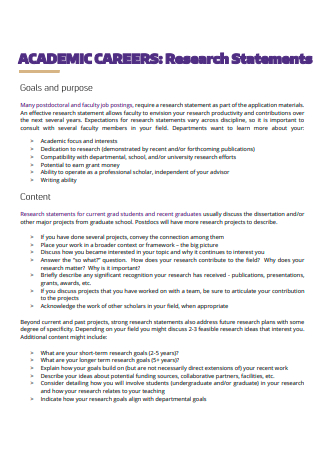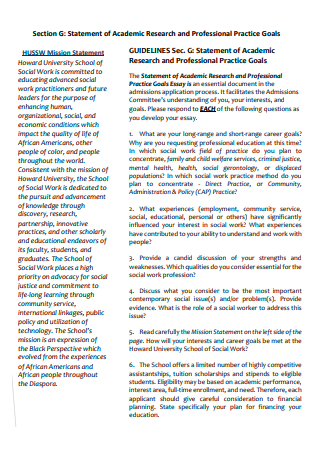3+ Sample Academic Research Statement
FREE Academic Research Statement s to Download
3+ Sample Academic Research Statement
What is an Academic Research Statement?
Different Types of Research Statements
Benefits of an Academic Research Statement
Basic Components of an Academic Research Statement
How to Write an Academic Research Statement
FAQs
What are the different types of research statements?
What are the fundamental elements of an academic research statement?
What are some examples of an academic research statement?
How to write a one page proposal for a research paper?
What is the difference between a research statement and research proposal?
What is an Academic Research Statement?
An academic research statement is a simple yet distinct piece of academic writing which comprises the principal ideas or key points about a certain academic research work of a graduate student or aspiring researcher, displaying the various scopes of the research and other fundamental elements involved in an academic research project. This is a beneficial document which will significantly help several prospective academic research faculty applicants who will impart the significance and impact of their research, particularly on how their academic research will bring about outstanding contributions to a specific field in the future.
According to a recent survey report, 64% of academics say they believe there should be a greater focus on real world experiences and “bringing the outside world in” more to elevate the learning experience from academic research. While another 64% of academics believe that content forms which include videos, podcasts, and infographics could help when presenting research work. Thus, it is very important for graduate students and aspiring researchers to develop an effective academic research statement.
Different Types of Research Statements
Collecting information concerning the current educational programs and results, analyzing information, developing an action plan to facilitate improvement, gathering changes after a new action plan being implemented, and setting up conclusions about the improvements are some of the methods being used in action research. However, what are different types of academic research statements that you need to develop? Below are different types of academic research statements that you may consider:
1. Descriptive Research Statement
This type of research statement is involved in quantitative research. Descriptive research statements are developed from a partially defined problem and seek to determine and present the answers to who, what, when, where, and how questions. This helps various business firms in segmenting and targeting markets while revealing the nature of consumer behaviour. The researcher should be able to maintain accuracy in his or her descriptive studies by striving for descriptive precision. Developing an effective descriptive research statement is a good way to get your application approved by school administrators or the research faculty.
2. Relational Research Statement
If you need to showcase your study which investigates the relation between two or more variables, you should create a research statement called relational research statement. Also known as correlational research study, a relational research study considers how different items relate or connect to one another or not as the researcher makes a comparison of different objects. So, create an enticing research statement for your relational or correlational research project.
3. Ethnographic Research Statement
The book Introduction to Ethnographic Research: A Guide to Anthropology stated that social scientists usually produce case studies in cultural anthropology and ethnography. Ethnography is a type of study that focuses on a specific culture at a specific place and time. As a researcher, it is essential to understand people in their personal environment through the application of methods which include participant observation and face-to-face interviewing. Writing an ethnographic research statement involves fully describing a particular culture outside of the researcher’s country of origin.
4. Historical Research Statement
Do you want to uncover a particular study according to primary historical data? The study of historical events like wars and revolutions is one example of historical research. Thus, it is wise to develop a simple yet structured historical research statement by stating a clear thesis, using factual evidence, upholding precision, watching the chronology, carefully citing sources, etc.
Benefits of an Academic Research Statement
Your CV, cover letter, teaching statement, especially your academic research statement require and deserve the similar level of care that you provide to any of the writing you do in your career. Moreover, what are some of the notable benefits of an academic research statement? You can read the details as follows:
1. Clarifies the Essence
Writing an academic research statement is a process that will guide the viewers such as the students or research committee to learn and understand the core of the academic research document, the fundamental points of the research, and where the academic research will lead to in the long run. A solid research statement of your academic work illustrates a clear narrative of how your completed research projects relate to your current research agenda and how your agenda is appropriate to the specific goals, resources, and needs of the institution to which you are applying. Thus, it is beneficial in clarifying the essence of your academic research work.
2. Facilitates Better Understanding
Your academic research achievements, your current research, and research you plan to conduct in the coming years are written in an academic research statement. With this crucial information, it will help the research committee and other educators in attaining adequate knowledge and insight, being skilled in formulating worthwhile decisions based on their personal inquiries and standards.
3. Elaborates the Content
Writing a compelling academic research statement is helpful in elaborating the overall content of the research work. Different from a personal statement, an academic research statement provides a well-detailed description of the research based on evidence. Dr. Karen Kelsky said that the golden rule of writing a research statement is to talk about the research, and not about yourself. Consult with your advisor about how much your research statement should be tailored to a specific position or institution.
4. Defines the Purpose
An academic research statement articulates the significance of your research work to your discipline, present logical research goals, or address the specific needs of an institution or position. So, explain the reason why you are motivated to start conducting academic research for the students or other factors involved in teaching and learning. In this process, you will also help yourself highlight your purpose and aim in the direction.
Basic Components of an Academic Research Statement
In this section, you will learn how to craft an impeccably-written academic research statement so that you are able to draw the attention of the readers of your research statement which include the research committee, administrators, and many others. However, a research statement contains different kinds of components. Take into account of the following elements for you to create a one-of-a-kind document:
How to Write an Academic Research Statement
Arranging your research project in a comprehensive range of context in a scientific way and setting up a clear guideline for following research achievements are helpful in your academic research statement writing. This document needs to be accomplished with intensive help such as the ongoing critique of dedicated readers and multiple edits. In this matter, we suggest that you follow the simple steps below while freely using one of our academic research statement templates in this article:
Step 1: Develop Your Dissertation Paragraph
The first step is you need to develop the dissertation paragraph. To accomplish this, you need to explain your primary goal and purpose of your academic research work. This is essential during job interviews, being the basis for several committees to comprehend your research work. So, write a clear and concise description about the research project you are working on. Provide theoretical frameworks, methodological framework, primary research questions, discovered results of your academic study, and many others.
Step 2: Include an Abstract
Next, write your abstract. Consider two kinds of abstract: a longer version which often reflects that basic structure of your research statement, and a section of your academic job materials mandated by the committee or faculty you’re applying to.
Step 3: Explain Your Academic Research Project
Discuss where you plan to venture your research. Explain carefully your ideas that may be connected to your academic work while not overstating your research agenda. Your work should be manageable within a certain period of time. For instance, contemplate what you would prefer to work on for the next five years and what you can realistically achieve in that amount of time. Include any external recognition of your work such as publications, grants, funding, or awards.
Step 4: Demonstrate Accuracy and Coherence
Demonstrating accuracy opens a way on how precisely the measured value or findings in your research project reflect the original values. Your research statement must be supported by evidence rather than storytelling. State facts about what you performed and why it matters for your discipline. On the other hand, coherence is crucial in maintaining the smooth flow of the sentences together. You may use some devices to link ideas within each sentence and paragraph in order to establish the logical bridge between words, sentences, and paragraphs.
Step 5: Highlight the Contribution of the Academic Research Work
What are the advantages and contributions of your academic research work? Point out the unique value and contribution of your work. Tell your readers on the significance of your research as you identify how your academic research fits into a broader area of research. Discuss tangible outcomes from your research. Aim on the importance of the questions you are asking or the methodology you are using.
Step 6: Prepare the Final Draft
Allow yourself sufficient time to draft. Anticipate that your document will have to undergo multiple revisions. Ask for some help from your work colleagues and other academic researchers in the field you have been working for effective proofreading and revision of your document so that you can submit your research statement correctly. After that, prepare the final draft of your academic research statement.
FAQs
What are the different types of research statements?
The different types of research statements are descriptive research statements, relational research statements, difference research statements, ethnographic research statements, legal research statements, objective research statements and subjective research statements.
What are the fundamental elements of an academic research statement?
When preparing your academic research statement, you need to consider these fundamental elements such as a brief description of a research problem or issue, a simple abstract of the academic research, clear interpretation of research methods and solutions, purpose, significance, benefits, references, and citations.
What are some examples of an academic research statement?
Some examples of an academic research statement are academic career research statement, academic research and professional goals statement, academic job market research statement, and academic analytics research statement.
How to write a one page proposal for a research paper?
Create a thought-provoking title and catchy introduction. Include a resource review. Elaborate the implementation of your methods. Predict your results. Elaborate the potential effect of the results.
What is the difference between a research statement and research proposal?
A research statement provides an explanation of the purpose behind a college or university application. On the contrary, a research proposal contains an explanation on what a researcher would prefer to take as his or her subject of research at the college or university he or she is applying to.
As most of the academic institutions and research institutes request a research statement as part of a job application, it is integral that you write a clear and effective academic research statement in order to clarify the essence, facilitate better understanding, elaborate the content, and define the purpose of your research work. Remember that the major principle of academic research statement writing is facts, not emotions. Thus, we recommend that you carefully follow the aforementioned tips and steps in this article so that you are able to craft a compelling and unique academic research statement. Plus, download our sample academic research statements here today!




